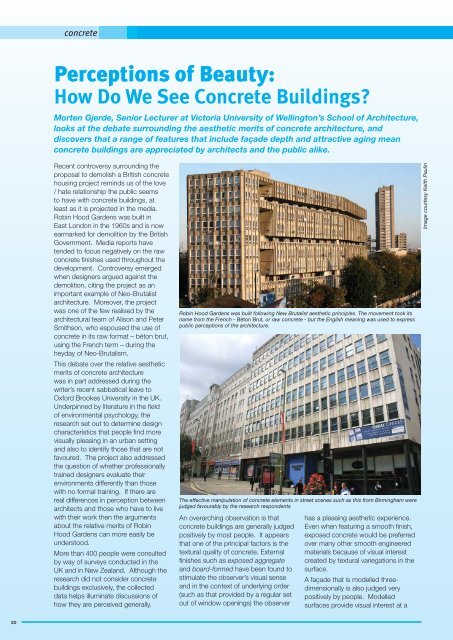Download PDF - CCANZ
Download PDF - CCANZ
Download PDF - CCANZ
Create successful ePaper yourself
Turn your PDF publications into a flip-book with our unique Google optimized e-Paper software.
10<br />
concrete<br />
Perceptions of Beauty:<br />
How Do We See Concrete Buildings?<br />
Morten Gjerde, Senior Lecturer at Victoria University of Wellington’s School of Architecture,<br />
looks at the debate surrounding the aesthetic merits of concrete architecture, and<br />
discovers that a range of features that include façade depth and attractive aging mean<br />
concrete buildings are appreciated by architects and the public alike.<br />
Recent controversy surrounding the<br />
proposal to demolish a British concrete<br />
housing project reminds us of the love<br />
/ hate relationship the public seems<br />
to have with concrete buildings, at<br />
least as it is projected in the media.<br />
Robin Hood Gardens was built in<br />
East London in the 1960s and is now<br />
earmarked for demolition by the British<br />
Government. Media reports have<br />
tended to focus negatively on the raw<br />
concrete finishes used throughout the<br />
development. Controversy emerged<br />
when designers argued against the<br />
demolition, citing the project as an<br />
important example of Neo-Brutalist<br />
architecture. Moreover, the project<br />
was one of the few realised by the<br />
architectural team of Alison and Peter<br />
Smithson, who espoused the use of<br />
concrete in its raw format – béton brut,<br />
using the French term – during the<br />
heyday of Neo-Brutalism.<br />
This debate over the relative aesthetic<br />
merits of concrete architecture<br />
was in part addressed during the<br />
writer’s recent sabbatical leave to<br />
Oxford Brookes University in the UK.<br />
Underpinned by literature in the field<br />
of environmental psychology, the<br />
research set out to determine design<br />
characteristics that people find more<br />
visually pleasing in an urban setting<br />
and also to identify those that are not<br />
favoured. The project also addressed<br />
the question of whether professionally<br />
trained designers evaluate their<br />
environments differently than those<br />
with no formal training. If there are<br />
real differences in perception between<br />
architects and those who have to live<br />
with their work then the arguments<br />
about the relative merits of Robin<br />
Hood Gardens can more easily be<br />
understood.<br />
More than 400 people were consulted<br />
by way of surveys conducted in the<br />
UK and in New Zealand. Although the<br />
research did not consider concrete<br />
buildings exclusively, the collected<br />
data helps illuminate discussions of<br />
how they are perceived generally.<br />
Robin Hood Gardens was built following New Brutalist aesthetic principles. The movement took its<br />
name from the French - Béton Brut, or raw concrete - but the English meaning was used to express<br />
public perceptions of the architecture.<br />
The effective manipulation of concrete elements in street scenes such as this from Birmingham were<br />
judged favourably by the research respondents<br />
An overarching observation is that<br />
concrete buildings are generally judged<br />
positively by most people. It appears<br />
that one of the principal factors is the<br />
textural quality of concrete. External<br />
finishes such as exposed aggregate<br />
and board-formed have been found to<br />
stimulate the observer’s visual sense<br />
and in the context of underlying order<br />
(such as that provided by a regular set<br />
out of window openings) the observer<br />
has a pleasing aesthetic experience.<br />
Even when featuring a smooth finish,<br />
exposed concrete would be preferred<br />
over many other smooth engineered<br />
materials because of visual interest<br />
created by textural variegations in the<br />
surface.<br />
A façade that is modelled threedimensionally<br />
is also judged very<br />
positively by people. Modelled<br />
surfaces provide visual interest at a<br />
Image courtesy Keith Paulin


